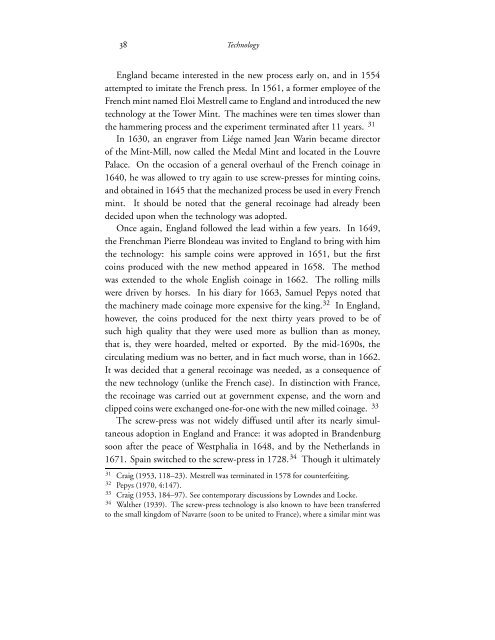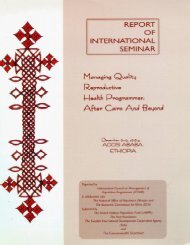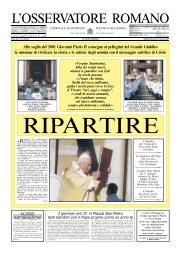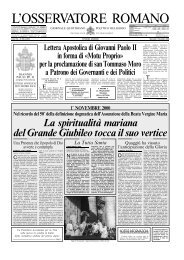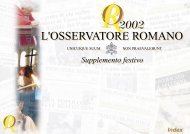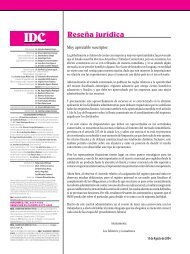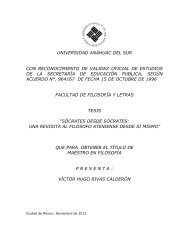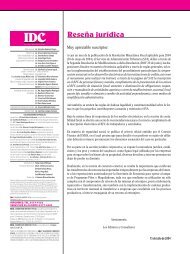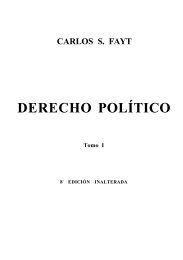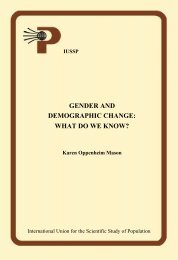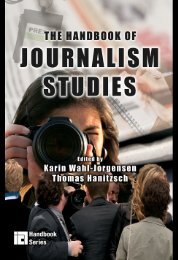The Evolution of Small Change: Beliefs, Experiments, and ...
The Evolution of Small Change: Beliefs, Experiments, and ...
The Evolution of Small Change: Beliefs, Experiments, and ...
Create successful ePaper yourself
Turn your PDF publications into a flip-book with our unique Google optimized e-Paper software.
38 Technology<br />
Engl<strong>and</strong> became interested in the new process early on, <strong>and</strong> in 1554<br />
attempted to imitate the French press. In 1561, a former employee <strong>of</strong> the<br />
French mint named Eloi Mestrell came to Engl<strong>and</strong> <strong>and</strong> introduced the new<br />
technology at the Tower Mint. <strong>The</strong> machines were ten times slower than<br />
the hammering process <strong>and</strong> the experiment terminated after 11 years. 31<br />
In 1630, an engraver from Liége named Jean Warin became director<br />
<strong>of</strong> the Mint-Mill, now called the Medal Mint <strong>and</strong> located in the Louvre<br />
Palace. On the occasion <strong>of</strong> a general overhaul <strong>of</strong> the French coinage in<br />
1640, he was allowed to try again to use screw-presses for minting coins,<br />
<strong>and</strong> obtained in 1645 that the mechanized process be used in every French<br />
mint. It should be noted that the general recoinage had already been<br />
decided upon when the technology was adopted.<br />
Once again, Engl<strong>and</strong> followed the lead within a few years. In 1649,<br />
the Frenchman Pierre Blondeau was invited to Engl<strong>and</strong> to bring with him<br />
the technology: his sample coins were approved in 1651, but the first<br />
coins produced with the new method appeared in 1658. <strong>The</strong> method<br />
was extended to the whole English coinage in 1662. <strong>The</strong> rolling mills<br />
were driven by horses. In his diary for 1663, Samuel Pepys noted that<br />
the machinery made coinage more expensive for the king. 32 In Engl<strong>and</strong>,<br />
however, the coins produced for the next thirty years proved to be <strong>of</strong><br />
such high quality that they were used more as bullion than as money,<br />
that is, they were hoarded, melted or exported. By the mid-1690s, the<br />
circulating medium was no better, <strong>and</strong> in fact much worse, than in 1662.<br />
It was decided that a general recoinage was needed, as a consequence <strong>of</strong><br />
the new technology (unlike the French case). In distinction with France,<br />
the recoinage was carried out at government expense, <strong>and</strong> the worn <strong>and</strong><br />
clipped coins were exchanged one-for-one with the new milled coinage. 33<br />
<strong>The</strong> screw-press was not widely diffused until after its nearly simultaneous<br />
adoption in Engl<strong>and</strong> <strong>and</strong> France: it was adopted in Br<strong>and</strong>enburg<br />
soon after the peace <strong>of</strong> Westphalia in 1648, <strong>and</strong> by the Netherl<strong>and</strong>s in<br />
1671. Spain switched to the screw-press in 1728. 34 Though it ultimately<br />
31 Craig (1953, 118–23). Mestrell was terminated in 1578 for counterfeiting.<br />
32 Pepys (1970, 4:147).<br />
33 Craig (1953, 184–97). See contemporary discussions by Lowndes <strong>and</strong> Locke.<br />
34 Walther (1939). <strong>The</strong> screw-press technology is also known to have been transferred<br />
to the small kingdom <strong>of</strong> Navarre (soon to be united to France), where a similar mint was


